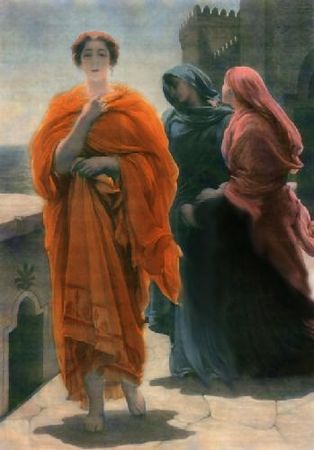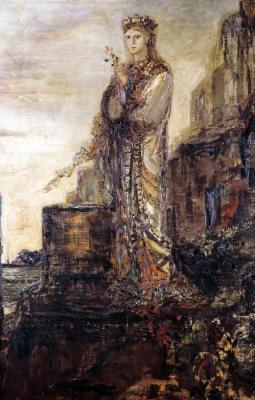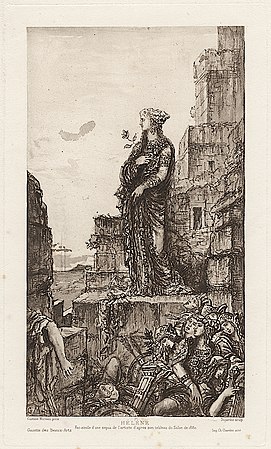Helen of Troy
| Helen | |
|---|---|
Queen of Sparta | |
| Member of the | |
| Consort | Menelaus, Paris, Deiphobus |
| Offspring | At least 5, including Hermione
|
Helen (
Elements of her putative biography come from classical authors such as Aristophanes, Cicero, Euripides, and Homer (in both the Iliad and the Odyssey). Her story reappears in Book II of Virgil's Aeneid. In her youth, she was abducted by Theseus. A competition between her suitors for her hand in marriage saw Menelaus emerge victorious. All of her suitors were required to swear an oath (known as the Oath of Tyndareus) promising to provide military assistance to the winning suitor, if Helen were ever stolen from him. The obligations of the oath precipitated the Trojan War. When she married Menelaus she was still very young; whether her subsequent departure with Paris was an abduction or an elopement is ambiguous (probably deliberately so).
The legends of Helen during her time in Troy are contradictory: Homer depicts her ambivalently, both regretful of her choice and sly in her attempts to redeem her public image. Other accounts have a treacherous Helen who simulated

Her beauty inspired artists of all times to represent her, frequently as the personification of ideal human beauty. Images of Helen start appearing in the 7th century BC. In classical Greece, her abduction by Paris—or escape with him—was a popular motif. In medieval illustrations, this event was frequently portrayed as a seduction, whereas in Renaissance paintings it was usually depicted as a "rape" (i. e., abduction) by Paris.[c] Christopher Marlowe's lines from his tragedy Doctor Faustus (1604) are frequently cited: "Was this the face that launched a thousand ships / And burnt the topless towers of Ilium?"[d]
Etymology
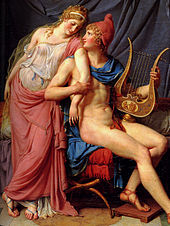
The etymology of Helen's name continues to be a problem for scholars. In the 19th century, Georg Curtius related Helen (Ἑλένη) to the moon (Selene; Σελήνη). But two early dedications to Helen in the Laconian dialect of ancient Greek spell her name with an initial digamma (Ϝ, probably pronounced like a w), which rules out any etymology originally starting with simple *s-.[7]
In the early 20th century, Émile Boisacq considered Ἑλένη to derive from the well-known noun ἑλένη meaning "torch".[8] It has also been suggested that the λ of Ἑλένη arose from an original ν, and thus the etymology of the name would be connected with the root of Venus. Linda Lee Clader, however, says that none of the above suggestions offers much satisfaction.[9][g]
More recently,
Others have connected the name's etymology to a hypothetical
Prehistoric and mythological context

Helen first appears in the poems of
Recent archaeological excavations in
Family
Helen and Menelaus had a daughter, Hermione. Different sources say she was also the mother of one or more sons, named Aethiolas, Nicostratus, Megapenthes and Pleisthenes. Still, according to others, these were instead illegitimate children of Menelaus and various lovers.
Helen and Paris had three sons, Bunomus, Aganus, Idaeus, and a daughter also called Helen.[22] The three sons died during the Trojan War when an earthquake caused the roof of the room where they slept to collapse.
Mythology
Birth
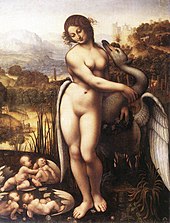

In most sources, including the
On the other hand, in the
Asclepiades of Tragilos and
Youthful abduction by Theseus

Two
is said to have aided the Dioscuri brothers in returning Helen home.In most accounts of this event, Helen was quite young;
[...] or like Helen, on the sands of Eurotas, between Castor and Pollux, one to be victor in boxing, the other with horses: with naked breasts she carried weapons, they say, and did not blush with her divine brothers there.
Suitors

When it was time for Helen to marry, many kings and princes from around the world came to seek her hand, bringing rich gifts with them or sent emissaries to do so on their behalf. During the contest, Castor and Pollux had a prominent role in dealing with the suitors, although the final decision was in the hands of Tyndareus.[41] Menelaus, her future husband, did not attend but sent his brother, Agamemnon, to represent him.
Oath of Tyndareus
Tyndareus was afraid to select a husband for his daughter, or send any of the suitors away, for fear of offending them and giving grounds for a quarrel. Odysseus was one of the suitors, but had brought no gifts because he believed he had little chance to win the contest. He thus promised to solve the problem, if Tyndareus in turn would support him in his courting of Penelope, the daughter of Icarius. Tyndareus readily agreed, and Odysseus proposed that, before the decision was made, all the suitors should swear a most solemn oath to defend the chosen husband against whoever should quarrel with him. After the suitors had sworn not to retaliate, Menelaus was chosen to be Helen's husband. As a sign of the importance of the pact, Tyndareus sacrificed a horse.[42] Helen and Menelaus became rulers of Sparta, after Tyndareus and Leda abdicated. Menelaus and Helen rule in Sparta for at least ten years; they have a daughter, Hermione, and (according to some myths) three sons: Aethiolas, Maraphius, and Pleisthenes.
The marriage of Helen and Menelaus marks the beginning of the end of the age of heroes. Concluding the catalog of Helen's suitors, Hesiod reports Zeus' plan to obliterate the race of men and the heroes in particular. The Trojan War, caused by Helen's elopement with Paris, is going to be his means to this end.[43]
Seduction or kidnapping by Paris

Paris, a Trojan prince, came to Sparta to claim Helen, in the guise of a supposed diplomatic mission. Before this journey, Paris had been appointed by Zeus to judge the most beautiful goddess; Hera, Athena, or Aphrodite. In order to earn his favour, Aphrodite promised Paris the most beautiful woman in the world. Swayed by Aphrodite's offer, Paris chose her as the most beautiful of the goddesses, earning the wrath of Athena and Hera.
Although Helen is sometimes depicted as being raped by Paris, Ancient Greek sources are often elliptical and contradictory. Herodotus states that Helen was abducted, but the Cypria simply mentions that after giving Helen gifts, "Aphrodite brings the Spartan queen together with the Prince of Troy."[44] Sappho argues that Helen willingly left behind Menelaus and their nine-year-old daughter, Hermione, to be with Paris:
Some say a host of horsemen, others of infantry and others
of ships, is the most beautiful thing on the dark earth
but I say, it is what you love
Full easy it is to make this understood of one and all: for
she that far surpassed all mortals in beauty, Helen her
most noble husband
Deserted, and went sailing to Troy, with never a thought for
her daughter and dear parents.— Sappho,fragment 16 (Voigt)[45]
-
The Abduction of Helen, painting by Girolamo Genga, circa 1510 (Musée des Beaux-Arts de Strasbourg).
-
In western painting, Helen's journey to Troy is usually depicted as a forced abduction. The Rape of Helen by Francesco Primaticcio (c. 1530–1539, Bowes Museum) is representative of this tradition.
-
In Guido Reni's painting (1631, Louvre, Paris), however, Paris holds Helen by her wrist (as he already did in Genga's painting shown here on the left), and leave together for Troia.
-
The Rape of Helen by Tintoretto (1578–1579, Museo del Prado, Madrid); Helen languishes in the corner of a land-sea battle scene.[48]
-
El Juicio de Paris by Enrique Simonet, c. 1904. This painting depicts Paris' judgement. He is inspecting Aphrodite, who is standing naked before him. Hera and Athena watch nearby.
In Egypt
At least three Ancient Greek authors denied that Helen ever went to Troy; instead, they suggested, Helen stayed in Egypt during the Trojan War. Those three authors are Euripides, Stesichorus, and Herodotus.
Herodotus adds weight to the "Egyptian" version of events by putting forward his own evidence—he traveled to Egypt and interviewed the priests of the temple (Foreign Aphrodite, ξείνη Ἀφροδίτη) at Memphis. According to these priests, Helen had arrived in Egypt shortly after leaving Sparta, because strong winds had blown Paris's ship off course. King Proteus of Egypt, appalled that Paris had seduced his host's wife and plundered his host's home in Sparta, disallowed Paris from taking Helen to Troy. Paris returned to Troy without a new bride, but the Greeks refused to believe that Helen was in Egypt and not within Troy's walls. Thus, Helen waited in Memphis for ten years, while the Greeks and the Trojans fought. Following the conclusion of the Trojan War, Menelaus sailed to Memphis, where Proteus reunited him with Helen.[52]
In Troy
When he discovered that his wife was missing, Menelaus called upon all the other suitors to fulfill their oaths, thus beginning the Trojan War.
The Greek fleet gathered in Aulis, but the ships could not sail for lack of wind. Artemis was enraged by a sacrilege, and only the sacrifice of Agamemnon's daughter, Iphigenia, could appease her. In Euripides Iphigenia in Aulis, Clytemnestra, Iphigenia's mother and Helen's sister, begs her husband to reconsider his decision, calling Helen a "wicked woman". Clytemnestra tries to warn Agamemnon that sacrificing Iphigenia for Helen's sake is, "buying what we most detest with what we hold most dear".[53][54]
-
Helen on the Ramparts of Troy was a popular theme in late 19th-century art – seen here a depiction byFrederick Leighton.
-
In a similar fashion to Leighton, Gustave Moreau depicts an expressionless Helen; a blank or anguished face.
-
Lithographicillustration by Walter Crane
-
Paul Dujardin after Gustave Moreau, Hélène, photogravure, 1880
Before the opening of hostilities, the Greeks dispatched a delegation to the Trojans under Odysseus and Menelaus; they endeavored without success to persuade Priam to hand Helen back. A popular theme, The Request of Helen (Helenes Apaitesis, Ἑλένης Ἀπαίτησις), was the subject of a drama by Sophocles, now lost.[i][55]
Homer paints a poignant, lonely picture of Helen in Troy. She is filled with self-loathing and regret for what she has caused; by the end of the war, the Trojans have come to hate her. When Hector dies, she is the third mourner at his funeral, and she says that, of all the Trojans, Hector and Priam alone were always kind to her:[56][57]
Wherefore I wail alike for thee and for my hapless self with grief at heart;
for no longer have I anyone beside in broad Troy that is gentle to me or kind;
but all men shudder at me.[58]
These bitter words reveal that Helen gradually realized Paris' weaknesses, and decided to ally herself with Hector. There is an affectionate relationship between the two, and Helen has harsh words for Paris when she compares the two brothers:[57][59]
Howbeit, seeing the gods thus ordained these ills,
would that I had been wife to a better man,
that could feel the indignation of his fellows and their many revilings. [...]
But come now, enter in, and sit thee upon this chair, my brother,
since above all others has trouble encompassed thy heart
because of shameless me, and the folly of Alexander.[60][56]
After Paris was killed in combat, there was some dispute among the Trojans about which of Priam's surviving sons she should remarry:
During the Fall of Troy

During the fall of Troy, Helen's role is ambiguous. In
After the deaths of Hector and Paris, Helen became the paramour of their younger brother, Deiphobus; but when the sack of Troy began, she hid her new husband's sword, and left him to the mercy of Menelaus and Odysseus. In Aeneid, Aeneas meets the mutilated Deiphobus in Hades; his wounds serve as a testimony to his ignominious end, abetted by Helen's final act of treachery.[62]
However, Helen's portraits in Troy seem to contradict each other. From one side, we read about the treacherous Helen who simulated Bacchic rites and rejoiced over the carnage of Trojans. On the other hand, there is another Helen, lonely and helpless; desperate to find sanctuary, while Troy is on fire. Stesichorus narrates that both Greeks and Trojans gathered to stone her to death.[63] When Menelaus finally found her, he raised his sword to kill her. He had demanded that only he should slay his unfaithful wife; but, when he was ready to do so, she dropped her robe from her shoulders, and the sight of her beauty caused him to let the sword drop from his hand.[j] Electra wails:[64]
Alas for my troubles! Can it be that her beauty has blunted their swords?
Fate
Helen returned to
According to another version, used by Euripides in his play Orestes, Helen had been saved by Apollo from Orestes[65] and was taken up to Mount Olympus almost immediately after Menelaus' return. A curious fate is recounted by Pausanias the geographer (3.19.11–13), which has Helen share the afterlife with Achilles.[66]
Pausanias also has another story (3.19.9–10): "The account of the Rhodians is different. They say that when Menelaus was dead, and
Tlepolemus was a son of Heracles and Astyoche. Astyoche was a daughter of Phylas, King of Ephyra who was killed by Heracles. Tlepolemus was killed by Sarpedon on the first day of fighting in the Iliad. Nicostratus was a son of Menelaus by his concubine Pieris, an Aetolian slave. Megapenthes was a son of Menelaus by his concubine Tereis, with no further origin.
In
Artistic representations
From Antiquity, depicting Helen would be a remarkable challenge. The story of Zeuxis deals with this exact question: how would an artist immortalize ideal beauty?[70] He eventually selected the best features from five virgins. The ancient world starts to paint Helen's picture or inscribe her form on stone, clay and bronze by the 7th century BC.[71] Dares Phrygius describes Helen in his History of the Fall of Troy: "She was beautiful, ingenuous, and charming. Her legs were the best; her mouth the cutest. There was a beauty-mark between her eyebrows."[72]
Helen is frequently depicted on Athenian vases as being threatened by Menelaus and fleeing from him. This is not the case, however, in Laconic art: on an Archaic stele depicting Helen's recovery after the fall of Troy, Menelaus is armed with a sword but Helen faces him boldly, looking directly into his eyes; and in other works of Peloponnesian art, Helen is shown carrying a wreath, while Menelaus holds his sword aloft vertically. In contrast, on Athenian vases of c. 550–470, Menelaus threateningly points his sword at her.[73]

The abduction by Paris was another popular motif in ancient Greek vase-painting; definitely more popular than the kidnapping by Theseus. In a famous representation by the Athenian vase painter Makron, Helen follows Paris like a bride following a bridegroom, her wrist grasped by Paris' hand.[74] The Etruscans, who had a sophisticated knowledge of Greek mythology, demonstrated a particular interest in the theme of the delivery of Helen's egg, which is depicted in relief mirrors.[75]
In Renaissance painting, Helen's departure from Sparta is usually depicted as a scene of forcible removal (rape) by Paris. This is not, however, the case with certain secular medieval illustrations. Artists of the 1460s and 1470s were influenced by Guido delle Colonne's Historia destructionis Troiae, where Helen's abduction was portrayed as a scene of seduction. In the Florentine Picture Chronicle Paris and Helen are shown departing arm in arm, while their marriage was depicted into Franco-Flemish tapestry.[76]
In Christopher Marlowe's Doctor Faustus (1604), Faust conjures the shade of Helen. Upon seeing Helen, Faustus speaks the famous line: "Was this the face that launch'd a thousand ships, / And burnt the topless towers of Ilium." (Act V, Scene I.) Helen is also conjured by Faust in Goethe's Faust.
In William Shakespeare's play Troilus and Cressida, Helen is a minor character who adores Troilus.
In Pre-Raphaelite art, Helen is often shown with shining curly hair and ringlets. Other painters of the same period depict Helen on the ramparts of Troy, and focus on her expression: her face is expressionless, blank, inscrutable.[77] In Gustave Moreau's painting, Helen will finally become faceless; a blank eidolon in the middle of Troy's ruins.
Cult
The major centers of Helen's cult were in Laconia. At Sparta, the urban sanctuary of Helen was located near the Platanistas, so called for the plane trees planted there. Ancient sources associate Helen with gymnastic exercises or/and choral dances of maidens near the
We first a crown of low-growing lotus
having woven will place it on a shady plane-tree.
First from a silver oil-flask soft oil
drawing we will let it drip beneath the shady plane-tree.
Letters will be carved in the bark, so that someone passing by
may read in Doric: "Reverence me. I am Helen's tree."
Helen's worship was also present on the opposite bank of Eurotas at Therapne, where she shared a shrine with Menelaus and the Dioscuri. The shrine has been known as the Menelaion (the shrine of Menelaus), and it was believed to be the spot where Helen was buried alongside Menelaus. Despite its name, both the shrine and the cult originally belonged to Helen; Menelaus was added later as her husband.[79] In addition, there was a festival at the town, which was called Meneleaeia (Μενελάεια) in honour of Menelaus and Helen.[80] Isocrates writes that at Therapne Helen and Menelaus were worshiped as gods, and not as heroes. Clader argues that, if indeed Helen was worshiped as a goddess at Therapne, then her powers should be largely concerned with fertility,[81] or as a solar deity.[82] There is also evidence for Helen's cult in Hellenistic Sparta: rules for those sacrificing and holding feasts in their honor are extant.[83]
Helen was also worshiped in Attica along with her brothers, and on
In popular culture
Pre-modern
Helen frequently appeared in
In the early Middle Ages, after the rise of Christianity, Helen was seen as a pagan equivalent to Eve from the Book of Genesis.[88] Helen was so beloved by early medieval Christians that she even took on some of the roles of the Virgin Mary.[88]
Modern
During the Renaissance, the French poet Pierre de Ronsard wrote 142 sonnets addressed to a woman named Hélène de Surgères,[88] in which he declared her to be the "true", French Helen, rather than the "lie" of the Greeks.[88]
Helen appears in various versions of the
In 1803, when French zoologist François Marie Daudin was to name a new species of beautifully colored snake, the trinket snake (Coelognathus helena), he chose the specific name helena in reference to Helen of Troy.[89]
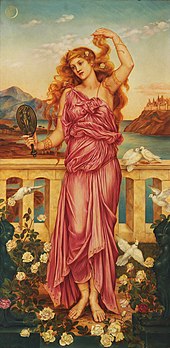
In 1864, Paris saw the premiere of the operetta La belle Hélène by Jacques Offenbach.
Helen of Troy is a minor character in the opera Mefistofele by Arrigo Boito, which received its premiere in Milan in 1868.
In 1881,
includes a fragment entitled "After Ten Years". In Egypt after the Trojan War, Menelaus is allowed to choose between the real, disappointing Helen and an ideal Helen conjured by Egyptian magicians.The English Pre-Raphaelite painter Evelyn De Morgan portrayed a sexually assertive Helen in her 1898 painting Helen of Troy.[88] Salvador Dalí was obsessed with Helen of Troy from childhood[88] and saw his wife Gala Dalí and the surrealist character Gradiva as the embodiments of Helen.[88] He dedicates his autobiography Diary of a Genius to "my genius Gala Gradiva, Helen of Troy, Saint Helen, Gala Galatea Placida."[88]
Minor planet 101 Helena discovered by James Craig Watson in 1868, is named after Helen of Troy.
20th century
John Erskine's 1925 bestselling novel The Private Life of Helen of Troy portrayed Helen as a "sensible, bourgeois heroine",[88] but the 1927 silent film of the same name, directed by Alexander Korda, transformed Helen into "a shopaholic fashion maven".[88]
In 1928, Richard Strauss wrote the German opera Die ägyptische Helena (The Egyptian Helena), which is the story of Helen and Menelaus's troubles when they are marooned on a mythical island.[91]
The 1938 short story, "Helen O'Loy", written by Lester del Rey, details the creation of a synthetic woman by two mechanics. The title is wordplay that combines "Helen of Troy" with "alloy".
The 1951 Swedish film Sköna Helena is an adapted version of Offenbach's operetta, starring Max Hansen and Eva Dahlbeck In 1956, a Franco-British epic titled Helen of Troy was released, directed by Oscar-winning director Robert Wise and starring Italian actress Rossana Podestà in the title role. It was filmed in Italy, and featured well-known British character actors such as Harry Andrews, Cedric Hardwicke, and Torin Thatcher in supporting roles.
The 1971 film The Trojan Women was an adaptation of the play by Euripides in which Irene Papas portrayed (a non-blonde) Helen of Troy.
In the 1998 TV series Hercules, Helen appears as a supporting character at Prometheus Academy as a student. Helen is caring and enthusiastic. She was the most popular girl in the academy and Adonis' girlfriend. Helen tries her best to keep Adonis from behaving stupidly, but mostly fails. She likes Hercules, but as a friend. She is a princess as in the myth but is not a half-sister of Hercules in the series. She was voiced by Jodi Benson.
21st century
A 2003 television version of Helen's life up to the fall of Troy,
Helen was portrayed by Diane Kruger in the 2004 film Troy. In this adaptation, as in the 2003 television version, she is unhappily married to Menelaus and willingly leaves with Paris, whom she loves. However, in this version she does not return to Sparta with Menelaus (who is killed by Hector), but escapes Troy with Paris and other survivors when the city falls.
Jacob M. Appel's 2008 play, Helen of Sparta, retells Homer's Iliad from Helen's point of view.[92]
Inspired by the line, "Was this the face that launched a thousand ships...?" from
In the
In the 2018 TV miniseries Troy: Fall of a City, Helen was portrayed by Bella Dayne.[97]
Pop singer-songwriter Al Stewart released a song called "Helen and Cassandra" on the reissue of his 1988 album Last Days of the Century. In it he addresses many aspects of the Helen myth and contrasts her with the seer Cassandra.
Indie pop singer Lorde released a song called "Helen of Troy" for the deluxe version of her 2021 album Solar Power.
See also
Notes
- ^ pronounced [helénɛː]
- ^ Name made popular by the 1956 film *Helen of Troy*.
- example needed]
- ^ However, the meeting with Helen in Marlowe's play and the ensuing temptation are not unambiguously positive, since they are closely followed by Faust's death and descent to Hell.
- ^ The name of Helen as worshipped at Sparta and Therapne began with a digamma. On the other hand, at Corinth, there is evidence of Helen without a digamma. Skutsch (Helen, 189 f. and passim) suggests that we have to make do "with two different names, two different mythological Helens".
- ^ Compare Proto-Indo-European *sa(e)wol, whence Greek helios, Latin sol, Sanskrit suryah, ultimately from *sawel "to shine". The relation with Selene is quite possible.
- Proto-Indo-European abduction myth. Saraṇyū means "swift" and is derived from the adjective saraṇa ("running, swift"), the feminine of which is saraṇā; this is in every sound cognate with Ἑλένα, the form of her name that has no initial digamma.[e] The possible connection of Helen's name to ἑλένη ("torch"), as noted above, may also support the relationship of her name to Vedic svaranā ("the shining one").[f][11]
- ^ In the 5th century comedy "Nemesis" by Cratinus, Leda was told to sit on an egg so that it would hatch, and this is no doubt the egg that was produced by Nemesis (Cratinus fr. 115 PCG; Gantz, Early Greek Myth, ibid).
- ^ Ancient writers do not agree on whether the embassy was dispatched before the gathering of the Greek army in Aulis or after it reached Tenedos or Troia. In Herodotus' account the Trojans swore to the Greek envoys that Helen was in Egypt, not in Troy; but the Greeks did not believe them, and laid siege to the city, until they took it.
Cypria. fr. 1.
Herodotus. Histories. II, 118: 2–4.
Homer. Iliad. III, 205.
Pseudo-Appolodorus. Epitome. 28–29. - ^ According to the ancient writers, it was the sight of Helen's face or breasts that made Menelaus drop his sword. See, inter alia, Aristophanes, Lysistrata, 155; Little Iliad, fr. 13 EGF.
* Maguire, Helen of Troy, 52 - ^ A shared cult of Helen and her brothers in Attica is alluded to in Euripides, Helen, 1666–1669. See also Edmunds, Helen's Divine Origins, 26–29. Concerning Helen Dendritis, Gumpert (Grafting Helen, 96), and Skutsch (Helen, 109) support that she was a vegetation goddess. Meagher (The Meaning of Helen, 43 f.) argues that her cult in Rhodes reflects an ancient fertility ritual associated with Helen not only on Rhodes but also at Dendra, near Sparta. Edmunds (Helen's Divine Origins, 18) notes that it is unclear what an ancient tree cult might be.
References
- ^ a b Cypria, fr. 9 PEG.
- ^ Galt, John, ed. (1837). The Complete Works of Lord Byron. Paris: Baudry's European Library. p. 553.
- ISBN 978-1465600868.
- ^ a b Smith, William, ed. (1870). A Dictionary of Greek and Roman Biography and Mythology. Vol. 2. Boston: Little, Brown, and Company. p. 370. ark:/13960/t9f47mp93.
- ^ Benjamin, S.G.W. (1880). Troy: Its Legend, History and Literature. C. Scribner's sons. p. v.
- ^ Way, Authur (1930). Euripides. Vol. 1. Londo & New York: William Heinemann, G. P. Putnam's Sons. p. 463. ark:/13960/t2v41093b.
- ISBN 978-0-19-928075-9.
- Perseus Project.
- ^ Clader, Helen, 63 f.; Skutsch, Helen, 191.
- ^ The American Heritage Dictionary, "Indo-European roots: wel₂".
- ^ Scutsch, Helen, 190 ff.
- ^ a b Skutsch, Otto. "Helen, her Name and Nature." In: Journal of Hellenic Studies 107 (1987), pp. 188–193.
- ISBN 978-0-86516-510-6.
- ISBN 1-884964-98-2, p. 164
- ^ Euripides, Robert E. Meagher, Helen, Univ of Massachusetts Press, 1986
- ^ O'Brien, Steven. "Dioscuric Elements in Celtic and Germanic Mythology". Journal of Indo-European Studies 10:1 & 2 (Spring–Summer, 1982), 117–136
- JSTOR 3270472.
- ISBN 978-0-19-928075-9.
- ^ Meagher, The Meaning of Helen, 11–18; Thompson, The Trojan War, 20
- ^ Hughes, Helen of Troy, 29
- JSTOR 40960624. Retrieved January 16, 2023.
- ISBN 9780241983386.
- ^ Homer, Iliad, III, 199, 418, 426; Odyssey, IV, 184, 219; XXIII, 218.
* Gantz, Early Greek Myth, 318–9 - ^ Euripides, Helen 16–21 Archived 2016-04-10 at the Wayback Machine, 257–59 Archived 2016-04-10 at the Wayback Machine
- ^ First Vatican Mythographer, VM I 204.
* Gantz, Early Greek Myth, 320–321; Hughes, Helen of Troy, 350; Moser, A Cosmos of Desire, 443–444 - ISBN 9780814201626.
- ^ Pseudo-Apollodorus, Bibliotheca, III, 10.7 Archived 2016-04-10 at the Wayback Machine
- ^ Athenaeus 8.334b-d, quoting the Cypria; Cypria, fr. 10 PEG.
- ^ Pseudo-Apollodorus, Bibliotheca, III, 10.7 Archived 2016-04-10 at the Wayback Machine
* Hard & Rose, The Roudledge Handbook, 438–439 - ^ Asclepiades 12F11, Pseudo-Eratosthenes Catast. 25.
- ^ Gantz, Early Greek Myth, ibid
- ^ Pausanias, 3.16.1
* Hughes, Helen of Troy, 26–27 - ^ Pausanias, 3.26.2
- ^ Hornblower, p. 142; Lycophron, 87
- ^ The most complete accounts of this narrative are given by Apollodorus, Diodorus 4.63.1–3, and Plutarch, Theseus 31–34. For a collection of ancient sources narrating Helen's abduction by Theseus, see Hughes, Helen, 357; Mills, Theseus, 7–8
- ^ Hellanicus, 4F134; Diodorus Siculus, 4.63.1–3
- ^ Stesichorus, fr. 191 PMG.
- ^ Gantz, pp. 289, 291.
- ^ Ovid, Heroides, 16.149–152; Propertius, 3.14
* Cairns, Sextus Propertius, 421–422; Hughes, Helen of Troy, 60; Pomeroy, Spartan Women, 28: "In the Roman period, because Sparta was a destination for tourists, the characteristics that made Sparta distinctive were emphasized. The athleticism of women was exaggerated." - The Walters Art Museum.
- ^ In the Hesiodic Catalogue of Women fr. 198.7–8, and 199.0–1, they are the recipients of the bridal presents. For further details, see A Catalog within a Catalog, 133–135
- ^ Hesiod, Catalogs of Women and Eoiae, fr. 204; Hyginus, Fables, 78; Pausanias, 3.20.9; Apollodorus, 3.10.9
* Cingano, A Catalog within a Catalog, 128; Hughes, Helen of Troy, 76 - ^ Cypria, fr. 1; Hesiod, Catalogs of Women and Eoiae, fr. 204.96–101
* Edmunds, Helen's Divine Origins, 7–8 - ^ Cypria, fr. 1; Herodotus, 113–119
- ^ Sappho, fr. 16. See an analysis of the poem by Gumpert, Grafting Helen, 92
- ^ Dio Chrysostom, Discourses, 1.37–53
* Hughes, Helen of Troy, 128–129 - ^ Cypria, fr. 1; Homer, Iliad, III, 443–445
* Cyrino, "Helen of Troy", 133–134 - ^ Kimmelman, Michael (March 1, 2007). "Lights! Darks! Action! Cut! Maestro of Mise-en-Scène". The New York Times. Retrieved July 11, 2009.
* Schjeldahl, Peter (February 12, 2007). "Venetial Brass". The New Yorker. Retrieved July 11, 2009. - ^ Allan, Introduction, 18–28
- ^ HELEN wsu.edu
- ^ a b Smoot, Guy (2012). "Did the Helen of the Homeric Odyssey ever go to Troy?". Washington, D.C.: Center for Hellenic Studies. Archived from the original on 2018-11-05. Retrieved 2018-11-04 – via The Center for Hellenic Studies.
- ^ Herodotus, 113–120; Kim, Homer, poet and historian, 30–35; Allan, Introduction, 22–24; Lindsay, Helen in the Fifth Century, 135–138
- ^ Euripides. Iphigenia in Aulis. 1166–1170.
- ^ Hughes. Helen of Troy. pp. 195–196.
- ^ About Euripides' lost drama, see Hughes. Helen of Troy. p. 191.
- ^ a b Hughes. Helen of Troy. p. 219.
- ^ a b Redfold. The Tragedy of Hector. p. 122.
- ^ Homer. Iliad. XXIV, 773–775.
- ^ Suzuki. Metamorphoses of Helen. p. 36.
- ^ Homer. Iliad. VI, 349–351, 354–356.
- ^ Homer, Odyssey, IV, 277–289; Virgil, Aeneid, 515–519.
* Hughes, Helen of Troy, 220; Suzuki, Metamorphoses of Helen, 99–100. - ^ Virgil, Aeneid 494–512
* Suzuki, Metamorphoses of Helen, 101–102. - ^ Stesichorus, fr. 201 PMG.
- ^ Euripides, Orestes 1286
- ^ Euripides and the Gods, Mary R. Lefkowitz
- ^ Blondell, Helen of Troy 46
- ^ "Pausanias, Description of Greece". Perseus.tufts.edu. Retrieved 2014-03-13.
- ^ Pierre Grimal, The Dictionary of Classical Mythology, s.v. "Helene p. 241"
- ^ Pliny, National History, 35.64–66. Cicero (De Inventione, 2.1–3) sets the story in Croton.
- ^ Mansfield, Too Beautiful to Picture, 29
- ^ Hughes, Helen of Troy 1–2
- ^ Dares of Phrygia. History of the Fall of Troy 12. A short prose work which purports to be a first hand account of the Trojan War by Dares, a Trojan priest of Hephaestus in the Iliad.
- ^ Pomeroy, Spartan Women, 169
- ^ Anderson, The Fall of Troy, 257; Matheson, Polygnotos and Vase Painting, 225
- ^ Caprino, Etruscan Italy, 66–71
- ^ David, Narrative in Context, 136; Hughes, Helen of Troy, 181–182
- ^ Maguire, Helen of Troy, 39–43, 47
- ^ Theocritus, The Epithalamium of Helen, 43–48
* Edmunds, Helen's Divine Origins, 12 - ^ Herodotus, Histories, VI, 61.3
* Hughes, Helen of Troy, 30–31; Lynn Budin, The Ancient Greeks, 286 - ^ "A Dictionary of Greek and Roman Antiquities (1890), MACELLUM, MATRA´LIA, MENELAEIA". www.perseus.tufts.edu.
- ^ Isocrates, Helen, 63;
Clader, Helen, 70;
Jackson, The Transformations of Helen, 52.
For a criticism of the theory that Helen was worshiped as a goddess in Therapne, see Edmunds, Helen's Divine Origins, 20–24. - ^ Euripides, Helen, translated by Robert E. Meagher, University of Massachusetts Press, Amherst 1986.
- ^ Pausanias, Description of Greece, III, 15.3, and 19.9;
Allan, Introduction, 14 ff.;
Calame, Choruses of Young Women, 192–197;
Pomeroy, Spartan Women, 114–118. - ^ Cited by Gumpert, Grafting Helen, 96, Edmunds, Helen's Divine Origins, 15–18, and Skutsch, Helen, 109. See critical remarks on this theory by Edmunds, Helen's Divine Origins, 16.
- ^ Calame, Choruses of Young Women, 201;
Eaverly, Archaic Greek Equestrian Sculpture, 9;
Pomeroy, Spartan Women, 162 f. - ^ ISBN 978-1-4051-2634-2.
- ^ ISBN 0-393-00443-0.
- ^ ISBN 978-0-19-973160-2.
- ISBN 978-1-4214-0135-5. ("Helena", p. 120).
- ^ "36. No Second Troy. Yeats, W. B. 1916. Responsibilities and Other Poems". Bartleby.com. Retrieved 2014-03-13.
- .
- ^ Horwitz, Jane. The Washington Post, December 16, 2008. P. C08.
- ^ The Humanism of Isaac Asimov[usurped]
- ^ "Helen of Troy Does Countertop Dancing by Margaret Atwood". Poemhunter.com. 20 January 2003. Retrieved 2014-03-13.
- ^ "Legends of Tomorrow Spoilers: "Helen Hunt"". DCLegendsTV. October 26, 2017. Retrieved November 14, 2017.
- ^ Burlingame, Russ. "'Legends of Tomorrow' Season Finale Will Feature Helen of Troy As An Amazon". comicbook.com. Retrieved 12 April 2018.
- ^ "'Troy: Fall Of A City': Bella Dayne, Louis Hunter & More Join BBC/Netflix Epic". Deadline. March 30, 2017. Retrieved April 1, 2017.
Additional references
Primary sources
- Aristophanes, Lysistrata. For an English translation see the Perseus Project.
- Cicero, De inventione II.1.1–2
- Cypria, fragments 1, 9, and 10. For an English translation see the Medieval and Classical Literature Library.
- Dio Chrysostom, Discourses. For an English translation, see Lacus Curtius.
- Euripides, Helen. For an English translation, see the Perseus Project.
- Euripides, Iphigenia in Aulis. For an English translation, see the Perseus project.
- Euripides, Orestes. For an English translation, see the Perseus Project.
- Herodotus, Histories, Book II. For an English translation, see the Perseus Project.
- Hesiod, Catalogs of Women and Eoiae. For an English translation see the Medieval and Classical Literature Library.
- Homer, Iliad, Book III; Odyssey, Books IV, and XXIII.
- Hyginus, Fables. Translated in English by Mary Grant.
- Isocrates, Helen. For an English translation, see the Perseus Project.
- Servius, In Aeneida I.526, XI.262
- Lactantius Placidus, Commentarii in Statii Thebaida I.21.
- Little Iliad, fragment 13. For an English translation, see the Medieval and Classical Literature Library.
- Ovid, Heroides, XVI.Paris Helenae. For an English translation, see the Perseus Project.
- Pausanias, Description of Greece, Book III. For an English translation, see the Perseus Project.
- .
- Sappho, fragment 16.
- Sextus Propertius, Elegies, 3.14. Translated in English by A.S. Kline.
- Theocritus, Idylls, XVIII (The Epithalamium of Helen). Translated in English by J. M. Edmonds.
- Virgil, Aeneid. Book VI. For an English translation see the Perseus Project.
Secondary sources
- Allan, William (2008). "Introduction". Euripides: Helen. ISBN 978-0-521-83690-6.
- Anderson, Michael John (1997). "Further Directions". The Fall of Troy in early Greek Poetry and Art. ISBN 0-19-815064-4.
- Blondell, Ruby (2013). Helen of Troy: Beauty, Myth, Devastation. Oxford University Press. ISBN 978-0-19-973160-2.
- Blondell, Ruby (2023). Helen of Troy in Hollywood. Princeton: Princeton University Press. ISBN 9780691229621.
- Cairns, Francis (2006). "A Lighter Shade of Praise". Sextus Propertius. Cambridge University Press. ISBN 0-521-86457-7.
- Calame, Claude (2001). "Chorus and Ritual". Choruses of Young Women in Ancient Greece (translated by Derek Collins and Janice Orion). Rowman & Littlefield. ISBN 0-7425-1525-7.
- Caprino, Alexandra (1996). "Greek Mythology in Etruria". In Franklin Hall, John (ed.). Etruscan Italy. ISBN 0-8425-2334-0.
- Chantraine, Pierre (2000). "Ἐλένη". Dictionnaire Étymologique de la Langue Gercque (in French). Klincksieck. ISBN 2-252-03277-4.
- Cingano, Ettore (2005). "A Catalog within a Catalog: Helen's Suitors in the Hesiodic Catalog of Women". In Hunter, Richard L. (ed.). The Hesiodic Catalog of Women. Cambridge University Press. ISBN 0-521-83684-0.
- Clader, Linda Lee (1976). Helen. Brill Archive. ISBN 90-04-04721-2.
- Cyrino, Monica S. (2006). "Helen of Troy". In Winkler, Martin M. (ed.). Troy: from Homer's Iliad to Hollywood. Cambridge University Press. ISBN 1-4051-3182-9.
- David, Benjamin (2005). "Narrative in Context". In Jenkens, Lawrence A. (ed.). Renaissance Siena. ISBN 1-931112-43-6.
- Eaverly, Mary Ann (1995). "Geographical and Chronological Distribution". Archaic Greek Equestrian Sculpture. ISBN 0-472-10351-2.
- Edmunds, Lowell (May 2007). "Helen's Divine Origins". Electronic Antiquity: Communicating the Classics. X (2): 1–44. Retrieved 2009-07-07.
- Frisk, Hjalmar (1960). "Ἐλένη". Griechisches Etymologisches Wörterbuch (in German). Vol. I. French & European Pubns.
- Gantz, Timothy (2004). Early Greek Myth. Baltimore, MD and London: The ISBN 0-8018-5362-1.
- Gumpert, Matthew (2001). "Helen in Greece". Grafting Helen. ISBN 0-299-17124-8.
- Hard, Robin; Rose, Herbert Jennings (2004). "the Trojan War". The Routledge Handbook of Greek Mythology. Routledge. ISBN 0-415-18636-6.
- Hornblower, Simon (2015). Lycophron: Alexandra: Greek Text, Translation, Commentary, & Introduction. Oxford University Press. ISBN 978-0199576708.
- Hughes, Bettany (2005). Helen of Troy: Goddess, Princess, Whore. New York: Alfred A. Knopf. ISBN 0-224-07177-7.
- Executive ed.: Joseph P. Pickert... (2000). "Indo-European roots: wel₂". The American Heritage Dictionary of the English Language. Houghton Mifflin Harcourt. ISBN 0-395-82517-2.
- Jackson, Peter (2006). "Shapeshifting Rape and Xoros". The Transformations of Helen. J.H.Röll Verlag.
- Kim, Lawrence (2010). "Homer, poet and historian". Homer Between History and Fiction in Imperial Greek Literature. ISBN 978-0-521-19449-5.
- Lindsay, Jack (1974). "Helen in the Fifth Century". Helen of Troy: Woman and Goddess. Rowman and Littlefield. ISBN 0-87471-581-4.
- Lynn Badin, Stephanie (2006). "Religion and Ideology". The Ancient Greeks. ABC-CLIO. ISBN 1-57607-814-0.
- Maguire, Laurie (2009). "Beauty". Helen of Troy. John Wiley and Sons. ISBN 978-1-4051-2635-9.
- Mansfield, Elizabeth (2007). "Helen's Uncanny Beauty". Too Beautiful to Picture. ISBN 978-0-8166-4749-1.
- Matheson, Susan B. (1996). "Heroes". Polygnotos and Vase Painting in Classical Athens. University of Wisconsin Press. ISBN 0-299-13870-4.
- Meagher, Robert E. (2002). The Meaning of Helen. Bolchazy–Carducci Publishers. ISBN 0-86516-510-6.
- Mills, Sophie (1997). "Theseus and Helen". Theseus, Tragedy, and the Athenian Empire. Oxford University Press. ISBN 0-19-815063-6.
- Moser, Thomas C. (2004). A Cosmos of Desire. University of Michigan Press. ISBN 0-472-11379-8.
- Nilsson, Martin Persson (1932). "Mycenaean Centers and Mythological Centers". The Mycenaean Origin of Greek Mythology. Forgotten Books. ISBN 1-60506-393-2.
- Pomeroy, Sarah B. (2002). "Education". Spartan Women. Oxford University Press. ISBN 0-19-513067-7.
- Redfield, James (1994). "The Hero". The Tragedy of Hector. ISBN 0-8223-1422-3.
- Rozokoki, Alexandra. "The Significance of the Ancestry and Eastern Origins of Helen of Sparta". Quaderni Urbinati Di Cultura Classica, New Series, 98, no. 2 (2011): 35–69. THE SIGNIFICANCE OF THE ANCESTRY AND EASTERN ORIGINS OF HELEN OF SPARTA.
- Skutsch, Otto (1987). "Helen, her Name and Nature". The Journal of Hellenic Studies. 107: 188–193. S2CID 161933465.
- Suzuki, Mihoko (1992). "The Iliad". Metamorphoses of Helen. ISBN 0-8014-8080-9.
- Thompson, Diane P. (2004). "The Fall of Troy – The Beginning of Greek History". The Trojan War. McFarland. ISBN 0-7864-1737-4.
- Whitby, Michael (2002). "Introduction". Sparta. Taylor & Francis. ISBN 0-415-93957-7.
External links
- An analysis of the legend including historical evidence of worship as a goddess.
- . New International Encyclopedia. 1905.
- . The American Cyclopædia. 1879.


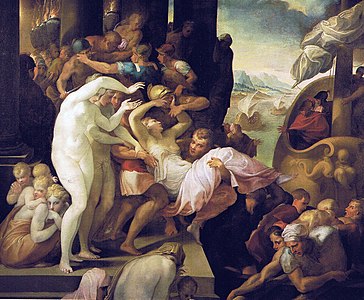
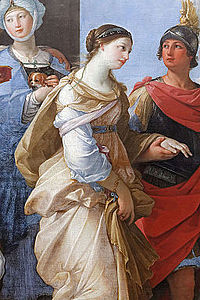
![The Rape of Helen by Tintoretto (1578–1579, Museo del Prado, Madrid); Helen languishes in the corner of a land-sea battle scene.[48]](http://upload.wikimedia.org/wikipedia/commons/thumb/5/59/Tintoretto_Rape_of_Helen.jpg/498px-Tintoretto_Rape_of_Helen.jpg)

